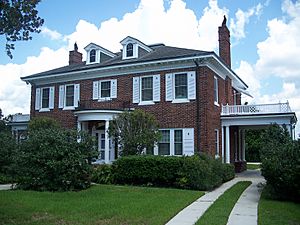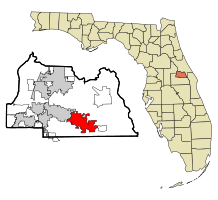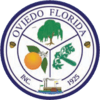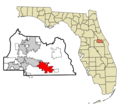Oviedo, Florida facts for kids
Quick facts for kids
Oviedo, Florida
|
||
|---|---|---|

The Wheeler-Evans House
|
||
|
||
| Motto(s):
"Growing in the right direction"
|
||

Location in Seminole County and the state of Florida
|
||
| Country | United States | |
| State | Florida | |
| County | Seminole | |
| Settled (Lake Jesup and Powell Settlements) | Early 1800s-1875 | |
| Incorporated (Town of Oviedo) |
1925 | |
| Incorporated (City of Oviedo) |
1967 | |
| Government | ||
| • Type | Council-Manager | |
| Area | ||
| • Total | 15.80 sq mi (40.92 km2) | |
| • Land | 15.52 sq mi (40.20 km2) | |
| • Water | 0.28 sq mi (0.72 km2) | |
| Elevation | 43 ft (13 m) | |
| Population
(2020)
|
||
| • Total | 40,059 | |
| • Density | 2,580.79/sq mi (996.43/km2) | |
| Time zone | UTC-5 (EST) | |
| • Summer (DST) | UTC-4 (EDT) | |
| ZIP codes |
32762, 32765, 32766
|
|
| Area code(s) | 407, 689, 321 | |
| FIPS code | 12-53575 | |
| GNIS feature ID | 2404447 | |
| Website | City of Oviedo, Florida Website | |
Oviedo (pronounced oh-VEE-doh) is a city in Seminole County, Florida, United States. In 2020, about 40,059 people lived there. Oviedo is part of the larger Orlando area.
Long ago, Oviedo was known for its old houses and farms. It was also famous for the chickens that walked freely in the downtown area! Even though Oviedo used to be a quiet, rural place, it has grown a lot recently. This is partly because it's close to the University of Central Florida and the Central Florida Research Park.
Contents
History of Oviedo
Early Settlements and Naming the City
In the early 1800s, the area where Oviedo is now was mostly empty. Only a few Seminole people and Black Seminoles (African Americans who lived with the Seminole tribe) called it home. The Seminoles mostly lived in other parts of Central Florida, like near Lake Jesup.
After the American Civil War, many people moved south to start new lives. Around 1875, a small group of settlers created the "Lake Jesup Settlement." Life was tough for these early settlers. They cooked outside, slept under mosquito nets, and burned rags to keep bugs away. But there was plenty of wildlife! This settlement quickly grew into a busy trading post.
In the late 1870s, people living south of Lake Jesup needed a local post office. Andrew Aulin, an early settler and shop owner, decided to open one. He wanted a unique Spanish name to honor Florida's Spanish past. He chose "Oviedo," named after a city and university in northern Spain. People think he might have pronounced it "oh-vee-AY-doh" back then.
Important People in Oviedo's Past
Many people helped shape Oviedo's history. George Powell was an early settler who owned a large area called the "Powell Settlement." This area now includes most of the northern part of the city, even downtown. One of his sons, Lewis Powell, became known for being involved in the plot to harm President Abraham Lincoln.
Henry Foster, a friend of George Powell, helped Oviedo's farming industry grow. He paid for a railway line to Oviedo, which made it easier to transport goods. He also started the Lake Jesup Steamboat Company. Farming, especially citrus and celery, was Oviedo's main business until the 1940s. Foster also helped create the First Methodist Church of Oviedo.
Another important person was Butler Boston, a citrus grower. He helped Oviedo's citrus farms by successfully growing tangerines and a special type of orange called the "temple orange." Butler Boston was a leader in the local Black community. He worked hard to improve education and helped build the Antioch Baptist Church. Today, many places in Oviedo, like Boston Street and Boston Cemetery, are named after him.
Andrew Duda Sr., an immigrant from Slovakia, started a farm nearby in the early 1900s. After some struggles, he returned in 1926 and became very successful. His farm even survived the Great Depression. In 1939, he built St. Luke's Lutheran Church, which is now a large church community. The Duda family also started a successful sod farm in the 1970s, which you can still see today.
Oviedo's Growth and Change
Oviedo grew a lot in the 1920s. New buildings and banks were built on "Broadway," the main street downtown. Some of these old buildings are still there. The Nelson and Co. packing house was a big part of Oviedo's farming industry for many years. However, after several cold winters in the 1980s, the farms closed down. By then, other businesses had become more important than farming.
Oviedo officially became a town in 1925 and then a city in 1967. In 1963, a "space university" was planned nearby. Many teachers and staff from this new university, now called the University of Central Florida, moved to Oviedo. This brought new businesses and jobs. The Central Florida Research Park, started in 1978, is now the biggest research park in Florida. All this growth has made Oviedo's population much larger. Sadly, the wild chickens and hogs that used to wander around are rarely seen anymore.
Geography and Climate
Where is Oviedo Located?
Oviedo is located at about 28°39′29″N 81°11′14″W.
The city covers about 40 square kilometers (15.4 square miles). Most of this is land, with a small amount of water. Oviedo is about 20 minutes away from downtown Orlando by highway. The Econlockhatchee River flows through the eastern part of the city, and a smaller river, the Little Econlockhatchee River, runs through the southern part.
Oviedo's Weather
Oviedo has a humid subtropical climate. This means it has hot, humid summers and generally mild winters.
Major Weather Events
- 2004 Hurricane Season: In August 2004, Hurricane Charley passed directly over Oviedo as a strong storm. More than half the city lost power for five to seven days. Schools were closed for a week. Many trees fell, and some homes were destroyed. This was the worst hurricane damage in Seminole County history. A month later, Frances and Jeanne also hit the area, causing more damage and power outages.
- Tropical Storm Fay (2008): Tropical Storm Fay stayed over Oviedo for days in 2008. It brought strong winds, heavy rains, and flooded roads.
- Hurricane Ian (2022): Hurricane Ian caused a lot of damage across Florida in 2022, and Oviedo was affected too. The city's lakes and the Little Econ River flooded, and entire streets in some neighborhoods were underwater.
Population of Oviedo
| Historical population | |||
|---|---|---|---|
| Census | Pop. | %± | |
| 1930 | 1,042 | — | |
| 1940 | 1,356 | 30.1% | |
| 1950 | 1,601 | 18.1% | |
| 1960 | 1,926 | 20.3% | |
| 1970 | 1,870 | −2.9% | |
| 1980 | 3,074 | 64.4% | |
| 1990 | 11,114 | 261.5% | |
| 2000 | 26,316 | 136.8% | |
| 2010 | 33,342 | 26.7% | |
| 2020 | 40,059 | 20.1% | |
| U.S. Decennial Census | |||
In 2020, Oviedo had 40,059 residents. There were 13,054 households and 10,790 families living in the city.
About 25.9% of the population was under 18 years old, and 9.8% was over 65 years old. More than half of the city's population (51.4%) was female. Most adults (95.4%) had graduated from high school, and many (43.9%) had a college degree.
Arts and Culture
Historic Downtown Area
Many buildings in Oviedo's historic downtown were built in the late 1800s and early 1900s. Some important places, like the Nelson and Company Historic District and the First Methodist Church of Oviedo, are listed on the National Register of Historic Places. The Oviedo Mall used to have murals showing historic areas and early settlers, but these were removed during renovations in 2022.
A project called the Oviedo Preservation Project takes photos and documents old buildings. This is important because some buildings are being taken down as State Road 434 is made wider.
In April 1875, an African-American pioneer named Mathew Powell started the Antioch Missionary Baptist Church.
New Developments and Attractions
In 2015, Oviedo opened a new downtown area called "Oviedo on the Park." It's just south of the old downtown. This new area has homes, restaurants, and shops. It's built around Center Lake Park, which has a man-made lake, a large outdoor theater, a playground, and a tribute to veterans.
The Oviedo Mall is an indoor shopping mall with a movie theater that opened in 1998.
Some local attractions include:
- The "Oviedo Lights": A unique roadside attraction.
- "The Rising": An annual walk that visits ten historic sites, with food and entertainment.
Library Services
The East Branch of the Seminole County Public Library System is located in Oviedo. The library offers many services, including curbside pick-up, 3D printing, free internet access, meeting rooms, and programs for children, teens, and adults.
Parks and Recreation
Oviedo has a Gym and Aquatic Center with a waterslide, water park, and pool. Riverside Park has a pool, tennis courts, and a skate park.
Other fun places include:
- Black Hammock Adventures: Offers airboat rides and a chance to see live alligators.
- Lukas Butterfly Encounter: A place to see many beautiful butterflies.
- The Pinball Lounge: Located in the Oviedo Bowling Center, it has the most pinball machines in Florida!
Local Media
Local newspapers like The Seminole Voice cover news in Seminole County, including Oviedo. The Oviedo Voice has been covering Oviedo news since 1993. The Oviedo Citizen is an online news source that started in 2008.
Healthcare
Oviedo Medical Center, a hospital with 64 beds and an emergency room, opened in 2017.
Sister City
Oviedo is a "sister city" with Oviedo, Spain. This connection started in 1877.
Notable People from Oviedo
Many interesting people have come from Oviedo, including:
- Mark Bellhorn, a professional baseball player.
- Denée Benton, a Broadway actress and singer.
- Blake Bortles, a retired professional football quarterback.
- Ryan Carpenter, a professional hockey player.
- Kayli Carter, an actress.
- Alwyn Cashe, a US Army soldier who received the Medal of Honor for his bravery.
- Jeff Driskel, a professional football quarterback.
- Zach Eflin, a professional baseball player.
- Riley Greene, a professional baseball player.
- Chaunte Lowe, an Olympic medalist in high jump.
- Tomas Nido, a professional baseball catcher.
- Jenny Simpson, an Olympic medalist and professional runner.
- Kayla Sims, a popular YouTuber and streamer.
- Monty Sopp, a professional wrestler known as "Billy Gunn."
- Shin-Tson Wu, an optical physicist and inventor of liquid crystal displays.
Images for kids
See also
 In Spanish: Oviedo (Florida) para niños
In Spanish: Oviedo (Florida) para niños




